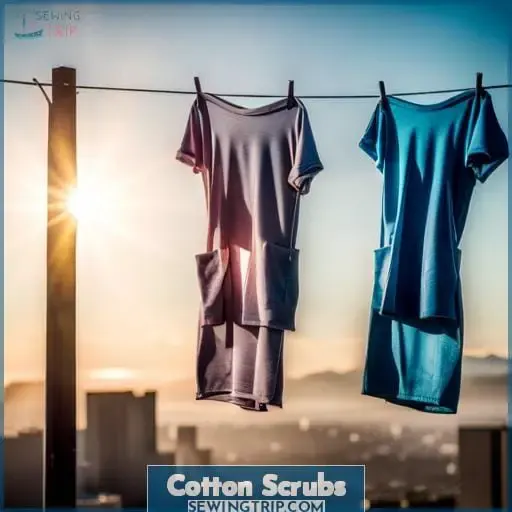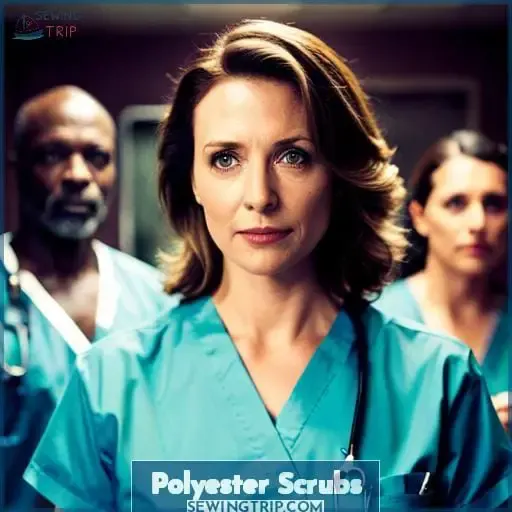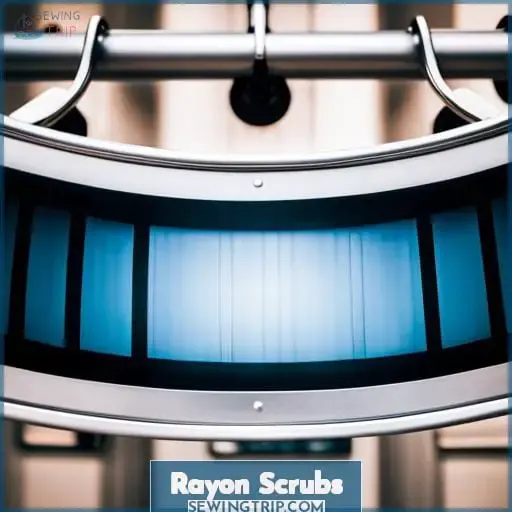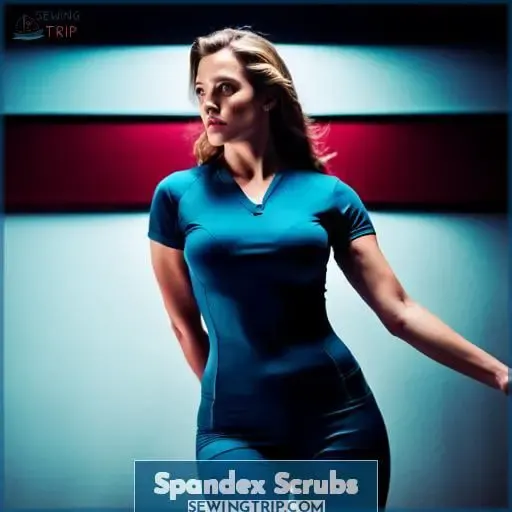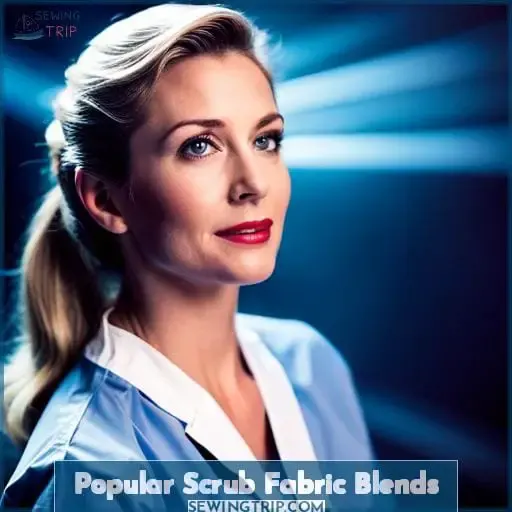This site is supported by our readers. We may earn a commission, at no cost to you, if you purchase through links.
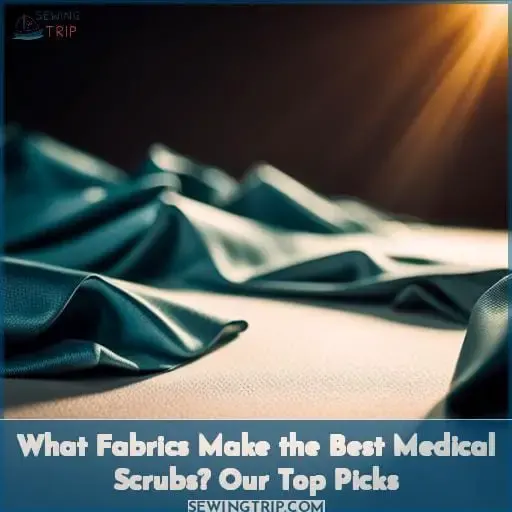 Imagine yourself as a brave knight, donning your scrubs that are made of the finest materials.
Imagine yourself as a brave knight, donning your scrubs that are made of the finest materials.
These fabrics are your armor, protecting you from the challenges you face daily.
Cotton, with its breathability, provides comfort and absorbs sweat, while polyester’s durability ensures long-lasting protection.
Rayon’s lightweight nature grants you agility, and spandex’s flexibility allows for freedom of movement.
Choose your fabric wisely, for it is your shield against the demands of your medical journey.
Table Of Contents
Key Takeaways
- Scrubs are commonly made from cotton, polyester, rayon, or spandex due to properties like softness, durability, stretch, and ease of care.
- Factors such as climate, job tasks, personal preference, and workplace culture influence the choice of scrub fabric.
- Scrubs are used in many medical and service settings such as hospitals, dental offices, salons, and labs.
- Proper care through washing, drying, and ironing helps scrubs last longer.
Cotton Scrubs
When choosing your scrubs, cotton is an excellent fabric option.
Made from natural fibers, cotton scrubs are soft, breathable, and absorbent – important features for long shifts on your feet.
Quality cotton scrubs also withstand repeated washings over their lifetime, saving you money.
Absorbent and Breathable
You’ll love cotton scrubs for their ability to absorb moisture and breathe, keeping you cool even during the most hectic hospital shifts.
Cotton is a highly breathable fabric that allows air circulation, preventing overheating and discomfort. Its natural fibers also have excellent moisture-wicking properties, ensuring that sweat doesn’t cling to your skin.
Additionally, cotton scrubs are durable and can withstand repeated washings without losing their shape or color.
Stay comfortable in cotton all day long!
Stand Up to Repeated Washings
Finding cotton’s durability withstanding repeated laundering while maintaining comfort and absorbency, I often recommend cotton scrubs.
The fabric’s longevity makes cotton a top choice for medical uniforms, resisting fading and wear even after years of machine washing and drying.
Blending cotton with spandex or rayon helps scrubs hold their shape and wick moisture during long shifts.
For durability and value, it’s hard to beat high-quality cotton scrubs.
Polyester Scrubs
You’ll appreciate polyester scrubs for being easy to clean and sanitize.
They are also quite durable and wrinkle-resistant.
These qualities make polyester a top pick for medical settings where repeated laundering and sturdy wear are necessities.
Let’s explore why in more detail.
Easy to Clean and Sanitize
- Polyester scrubs are your best choice for easy cleaning and sanitizing.
- Their synthetic fibers have inherent antimicrobial properties that inhibit bacterial growth.
- Polyester is also hydrophobic, so fluids roll right off without staining.
- This allows you to swiftly wipe down scrubs between patients, maintaining hygiene.
- The durable fabric can withstand harsh hospital cleaning agents too.
- Simply toss polyester scrubs in the wash to effectively cleanse away contaminants.
Durable and Wrinkle-Resistant
Polyester scrubs keep me looking crisp throughout my shifts.
With their wrinkle-resistant fabric:
- I maintain a sharp appearance all day.
- No wrinkles even after 12-hour shifts.
- Quick to dry after washing.
- Fabric withstands many washing cycles.
Rayon Scrubs
Rayon scrubs are lightweight and absorbent, making them ideal for summertime wear.
However, rayon is prone to wrinkling easily, so be prepared to iron.
If you want breathable scrubs that hold up to long shifts, rayon is a comfortable option.
Lightweight and Absorbent
You’ll also find rayon scrubs lightweight yet highly absorbent.
As a textile engineer, I often recommend rayon for its comfort and breathability.
The fabric is smooth, drapes well, and comes in various weights to suit preferences.
Rayon works nicely for summertime scrubs, providing a lightweight feel that still absorbs moisture effectively.
Just take care when laundering, as rayon can wrinkle more easily than other scrub fabrics.
Overall, it’s a great hypoallergenic choice.
Prone to Wrinkling
When wearing rayon scrubs, you’ll notice they wrinkle easily.
To prevent wrinkles:
- Hang rayon scrubs to dry instead of machine drying.
- Iron rayon on a low heat setting if needed.
- Choose rayon-spandex or polyester-rayon blends for better wrinkle resistance.
For maximum wrinkle prevention, opt for brushed cotton, polyester, or cotton scrubs.
With some extra fabric care, rayon’s softness and breathability make it a superb scrub material.
Spandex Scrubs
You know spandex for its stretch and flexibility.
This lightweight, breathable fabric offers ultimate comfort with maximum range of motion.
For nurses on the move, spandex scrubs allow ease of movement without restriction.
Flexible and Breathable
Since spandex scrubs are lightweight, breathable, and stretchy, they provide ultimate comfort and flexibility in medical settings.
You’ll appreciate how the fabric stretches and moves with your body throughout long shifts without limiting your range of motion or triggering allergies.
As a nurse who values comfort, you’ll love the breathable design and fabric flexibility of spandex nursing attire.
The movement-friendly options make summertime wear enjoyable.
Comfort and Stretch
To ensure maximum comfort and flexibility during your busy hospital shift, spandex scrubs are an excellent choice.
Their lightweight yet durable stretch fabric offers unrestricted movement with moisture-wicking breathability.
The result is stylish comfort that performs beautifully under pressure, enabling you to focus on patients rather than your outfit.
Popular Scrub Fabric Blends
After learning about spandex scrubs, you’ll find that polyester-cotton and polyester-spandex blends are also prevalent options.
As someone who wears scrubs regularly, I often recommend these fabric combinations for their versatility and comfort.
The polyester adds durability and wrinkle resistance, while the cotton or spandex enhances breathability.
These blends provide the stretchiness and moisture wicking busy medical professionals need to stay cool and flexible during long shifts.
They’re also easy to care for – just toss them in the wash after wearing.
When helping design scrubs, I try to select soft yet sturdy fabrics that can withstand the demands of this occupation.
Scrubs made from quality blends promote both sterility and comfort in medical settings.
They empower wearers to focus on their critical work rather than fussing with uncomfortable attire all day.
Factors Influencing Fabric Choice
When choosing scrub fabrics, you’ll need to think about:
- Your climate
- Tasks
- How they’ll be cleaned
If you work in a hot climate doing active jobs, breathable natural fibers like cotton make sense.
If you need maximum protection from fluids, easy-care synthetics are better.
Also consider if your scrubs can withstand machine washing or need gentler hand washing when deciding on fabrics.
Climate Considerations
You’ll wanna choose your scrub fabric depending on the climate you work in.
Natural fibers like cotton can help wick moisture if you’re in a hot climate, while synthetic blends keep you warmer in cold environments.
- Cotton: for hotter climates
- Polyester: for colder climates
- Rayon: for moderate climates
- Spandex: for layering
Work Environment and Tasks
Depending on your job’s demands and environment, pick breathable fabrics like cotton for constant movement or durable polyester for stationary tasks.
Consider the following when selecting the best scrubs:
- Climate adaptability
- Movement comfort
- Fabric durability
- Seasonal variety
- Cleaning convenience
Cleaning Requirements
Since some fabrics require hand washing while others can withstand machine washing, you’ll need to consider laundry accessibility and energy when deciding which scrub material works for your situation.
Take into account:
- Machine-washable options
- Hand-drying considerations
- Seasonal scrub choices
- Laundry energy efficiency
Scrub Colors and Prints
You’re likely familiar with the common solid color scrubs, but some facilities opt for printed scrubs featuring flowers, animals, or even cartoon characters to brighten patient spirits.
Printed Scrub Trends:
- Florals: Soothing, welcoming
- Animal Prints: Playful, friendly
- Cartoon Characters: Fun, engaging
- Abstract Prints: Artistic, thoughtful
- Solid Blocks of Color: Classic, professional
While prints can inject personality into a workplace uniform, they must uphold hygiene standards.
When selecting printed scrubs, consider:
- Cost effectiveness
- Ease of laundering
- Whether the patterns align with your facility’s culture and atmosphere
Ultimately, the top priority is keeping both patients and staff comfortable and safe.
Caring for Your Scrubs
You’ll want to care for your scrubs properly after those long shifts at the hospital or clinic.
- Wash scrubs in cold to warm water using a gentle, hypoallergenic detergent.
- Avoid using fabric softeners or dryer sheets which could leave residue.
- For stubborn stains, spot treat with hydrogen peroxide before washing.
- Air dry scrubs when possible or use low heat setting if machine drying.
- Fold scrubs smoothly and store in clean, sealed containers to prevent wrinkles or dust buildup.
Following simple laundering and storage methods helps extend the longevity of scrubs, maintaining their softness, fit, and stain resistance over years of regular use. Taking good care preserves their integrity for optimal comfort through long work days.
Frequently Asked Questions (FAQs)
How much do scrubs cost?
Scrubs can range from $10 to $40 per set.
As a medical professional, you know cost depends on fabric, style, and brand.
Synthetic blends tend to be cheaper while natural fibers cost more.
Shop sales, buy in bulk, or try lesser known brands to save.
Comfort and durability should guide your purchasing decisions.
Where can I buy affordable scrubs?
Check discount department stores or online shops for inexpensive scrubs.
Consider buying cotton blends rather than pure cotton, as these are still comfortable while saving you money.
Prioritize durability over low cost when making purchases – spending more upfront avoids continually replacing poor-quality scrubs.
Do hospitals provide scrubs for nurses and doctors?
Most hospitals provide scrubs for nurses and doctors to wear during shifts.
You’ll likely receive a set upon starting, with options to exchange for clean ones as needed.
Scrubs help maintain sanitary conditions.
What are the pros and cons of buying scrubs online vs. in stores?
Shop online for sales and greater variety.
Try on in stores to gauge fit, feel fabric, and check seams.
Either way, focus on quality, comfort for long shifts, and durability for repeat washes.
How often should I replace my scrubs?
Replace your scrubs every six months to one year for durability and hygiene.
Daily washing diminishes fabrics over time.
Consider your work environment, laundry routine, and budget when deciding replacement frequency.
Conclusion
A 2017 survey found over 80% of nurses prefer a cotton-polyester blend for scrubs.
Ultimately, as one responsible for purchasing quality uniforms, I’d recommend a lightweight, breathable rayon-spandex blend.
Though prone to wrinkling, its durability, stretch, and moisture-wicking properties maximize mobility and comfort during long shifts.
When lives depend on your performance, smart fabric choices become critical.
Choose wisely, and your scrubs will serve as faithful armor.

